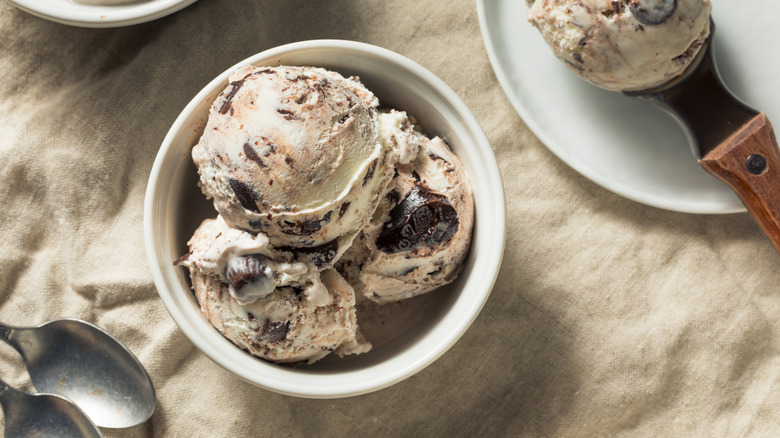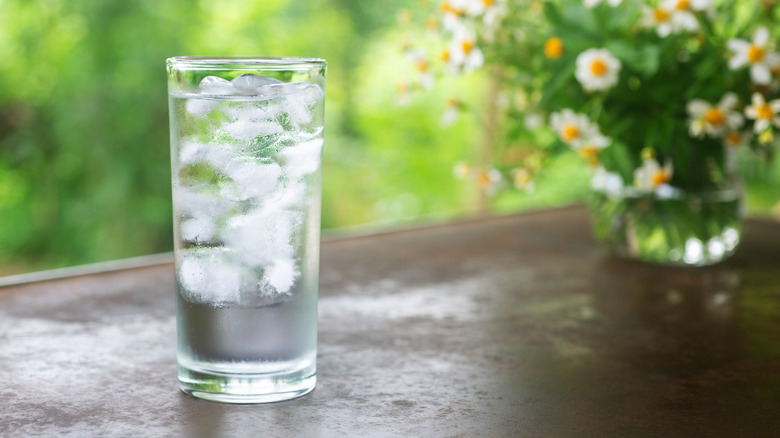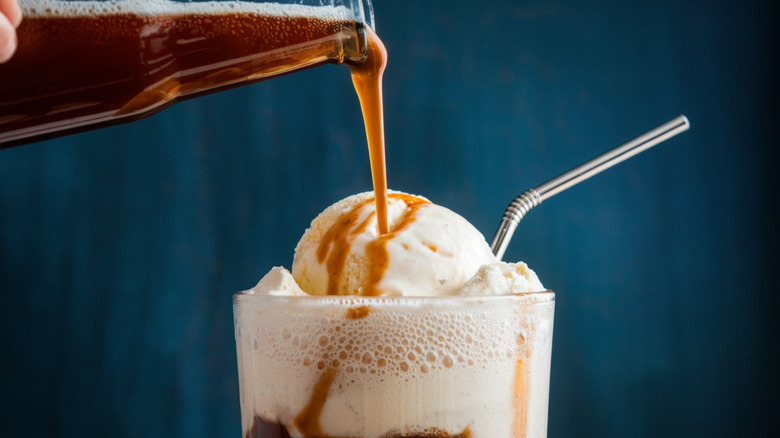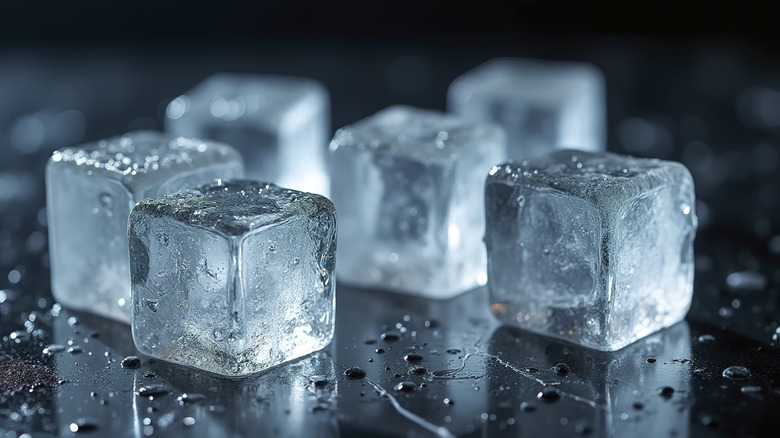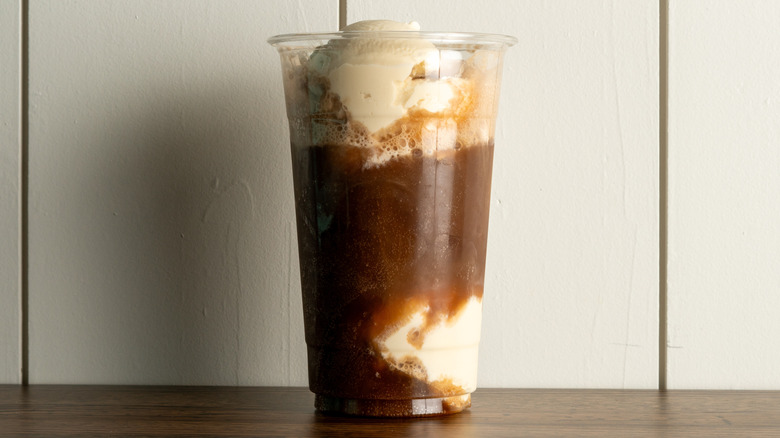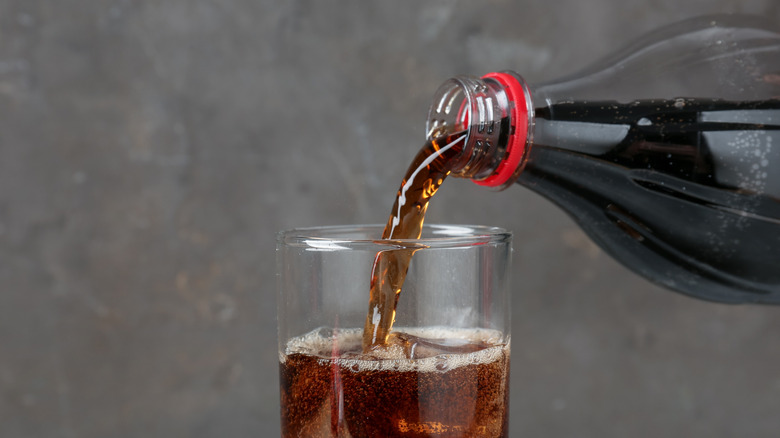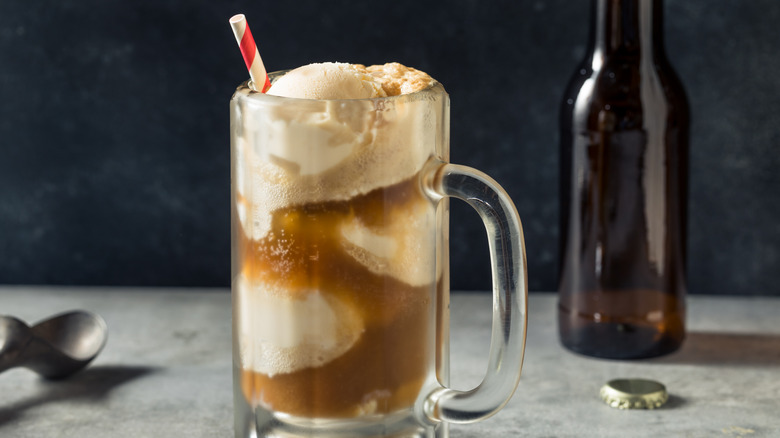9 Mistakes To Avoid When Making Ice Cream Floats
Ice cream floats are a hybrid treat that's hard not to love. When the creaminess of the ice cream and the fizziness of the soda come together, it's a match made in dessert heaven. It's sweet, of course, but depending on what kind of soda you use, it can also have a lovely acidity that really ties the whole beverage-dessert combo together. It may seem like ice cream floats are super easy to make at home — after all, you're just combining ice cream and soda in a glass, right? But in reality, constructing a quality ice cream float can be trickier than it seems.
That's why we've compiled a list of some of the most common mistakes people make when they're making ice cream floats. We talked to some bonafide ice cream float experts, including chef Sydney Yocum, research chef at Creative Food Solutions; Andia Xouris, co-founder and CEO of Andia's Ice Cream; executive pastry chef Deden Putra of Pechanga Resort Casino; and Janice Kuz, owner of The Nines Emporium, to get the scoop on what mistakes to avoid — and how to perfect your next ice cream float.
Not using a high-quality ice cream with high butterfat percentage
Since you're not eating the ice cream in your float all on its own, you may assume that you can skimp on quality and just grab the cheapest pint available at the grocery store. But if you want your ice cream float to turn out as tasty — and as creamy — as possible, you're going to want to use a high-quality ice cream, says chef Sydney Yocum. "Most people will go for any type of ice cream they have on hand, but choosing the right type of ice cream is important," she explains. "The higher the quality of the ice cream, the better the float."
So, what determines an ice cream's quality? There are a few different factors to consider, but the butterfat percentage is one of them. "When choosing an ice cream, go for one with a higher butterfat percentage," she suggests. So, no, you shouldn't be using a low-fat ice cream here. By opting for a richer, creamier ice cream, you'll be guaranteed a tastier ice cream float.
Choosing unconventional ice cream flavors
There are tons of fun ice cream and soda combos you can lean into for an interesting ice cream float. But even though you can experiment with different ice cream flavors, you shouldn't opt for one that's too unconventional — or one that has a lot of little bits and pieces that will sink to the bottom of your glass. Generally, we suggest opting for vanilla ice cream, especially if you're going for that classic float flavor. Vanilla's sweet but subtle flavor pairs well with just about any kind of soda, and it's not likely to clash with even bolder soda flavors.
Chocolate ice cream may also work well, as can coconut, if you want to opt for a fruitier flavor profile. However, pieces with large chunks of chocolate or other fillings aren't ideal, and funkier ice cream flavors may clash with the soda of your choosing. When in doubt about your ice cream float, opt for simplicity for the tastiest results.
Not starting with a chilled glass
An ice cream float is a dessert that's cold by design. Of course, you want your soda to be nice and cold, but it's even more important for the ice cream to remain as chilled as possible while you're enjoying the drink, so it doesn't melt. That's why you may want to consider using a chilled glass to serve your ice cream float in. Deden Putra, the executive pastry chef at Pechanga Resort Casino, says that not using a chilled glass is a mistake many home cooks can make with ice cream floats. "Always start with a chilled glass," he suggests.
Why is using a chilled glass so important when it comes to making an ice cream float? According to Putra, "It keeps the ice cream from melting too fast, so you get that creamy texture instead of a watery mess." Using a room-temperature glass may be a bit easier (and require less advance planning), but the last thing you want is an ice cream float that melts too much before you can get through it.
Forgetting to keep the ingredients cold until they're ready to serve
We've already discussed making sure that your glass is ice cold before you start constructing your ice cream float, but what about the ingredients involved? According to Sydney Yocum, you should keep them as cold as possible as well. "Keep all ingredients at the correct temperature right up until it is time to make the float," she says. "This means leaving the ice cream in the freezer and the soda in the fridge until you are ready to make it."
If you're busy in the kitchen, it can be easy to start taking ingredients out of the fridge before you're actually ready to build your float. However, the ice cream will start melting almost immediately once you take it out of the freezer. And since you don't want the ice cream to melt and get too watery right away, you'll want to make sure that the ice cream is totally frozen and that the soda is nice and cold when you actually serve everything in your glass.
Using ice cubes in your float
Since it's so important to keep the ingredients in your ice cream float as cold as possible for as long as possible, you might assume that it's a good idea to throw some ice cubes into your float. Technically, this will keep your drink at a colder temperature. However, there's also a major downside to adding ice cubes to the dessert: It's going to water down all of the other ingredients. The last thing you want is to be drinking an ice cream float made with watery, thin soda — that flavor intensity is important when it comes to helping the soda stand up to the creamy intensity of the ice cream.
And once the ice cream itself starts to get thin and watery? It's all downhill from there, and you're probably not even going to want to touch the rest of your float. So, if you care about maintaining that ideal flavor balance between ice cream and soda, refrain from adding any ice cubes to the mix.
Adding in the ice cream before pouring in the soda
According to Andia Xouris, the order in which you add the ingredients to the glass is super important to achieving the best possible ice cream float. Xouris, who is a Grand Master Ice Cream Chef, says, "Always pour soda in the glass before scooping the ice cream into it." That means that you'll get the soda out of the fridge first and pour it into your glass before removing the ice cream from the freezer and adding a scoop of it to the dessert.
"Ideally, pour the soda into the glass halfway up and then add a scoop of ice cream gently by letting it touch the side of the glass and letting it slowly roll down the glass, so it doesn't plop inside and cause foam," she suggests. This way, you're not going to end up with a mess on your kitchen counter, and you won't be dealing with a flat soda just a few sips into your treat.
Pouring the soda too fast
However, not every expert agrees that the soda should go into the glass first. According to Janice Kuz, it's okay to add the soda to a glass that contains ice cream — as long as you make sure to do it the right way. One of the biggest mistakes she sees home cooks make with floats? "A common pitfall is pouring the soda too fast over the ice cream, leading to massive fizz-overs and lost carbonation," she explains. First of all, that's going to be messy. Secondly, you're going to be left with a flat soda that doesn't have any of the fizz you're craving from an ice cream float.
Wondering how to pour the soda in the right way? According to Kuz, you should "add your quality ice cream first, then slowly pour the chilled soda down the side of the glass to maintain that essential fizz and minimize mess." Sounds like a simple enough solution!
Forgetting to serve your ice cream float with a straw and a spoon
When it comes to a dessert hybrid like an ice cream float, it only makes sense that one utensil will just not do. After all, half of the dessert is a drink, and the other is ice cream — two foods that you eat with very different utensils. A lot of home cooks make the mistake of only serving one of these two utensils, but that'll leave you either trying to suck thick ice cream out of a thin straw or spoon up tiny bits of soda.
That's why you're going to want to serve your ice cream float with both a straw and a spoon. That way, you'll be able to easily tackle every aspect of the dessert with one of the utensils provided. Whether you want a more soda- or ice cream-dominant bite, you'll be covered. Of course, once the ice cream melts enough, you can ditch your spoon if you want and just focus on the straw.
Using soda that's starting to go flat
Flat soda is undeniably depressing. Something about the lack of fizz makes the sweetness taste cloying — and somehow, the drink will still seem watery anyway. That's why it's absolutely essential to avoid using flat soda in your ice cream float. According to Janice Kuz, "Another key [to making a good ice cream float] is using fresh, highly carbonated soda," in addition to good-quality ice cream, of course. "The magic is in the creamy fizz," she says. And without fresh soda, that fizz will be nonexistent.
Ideally, you'll want to open up a new bottle of soda for your ice cream float. If you're just making one float, you can simply use a single serving-size bottle. However, if you're making enough floats for a crowd, a two-liter will do. Just make sure that it hasn't been opened and isn't sitting in your fridge for too long, and you'll have the fizzy, creamy dessert of your dreams every time.


